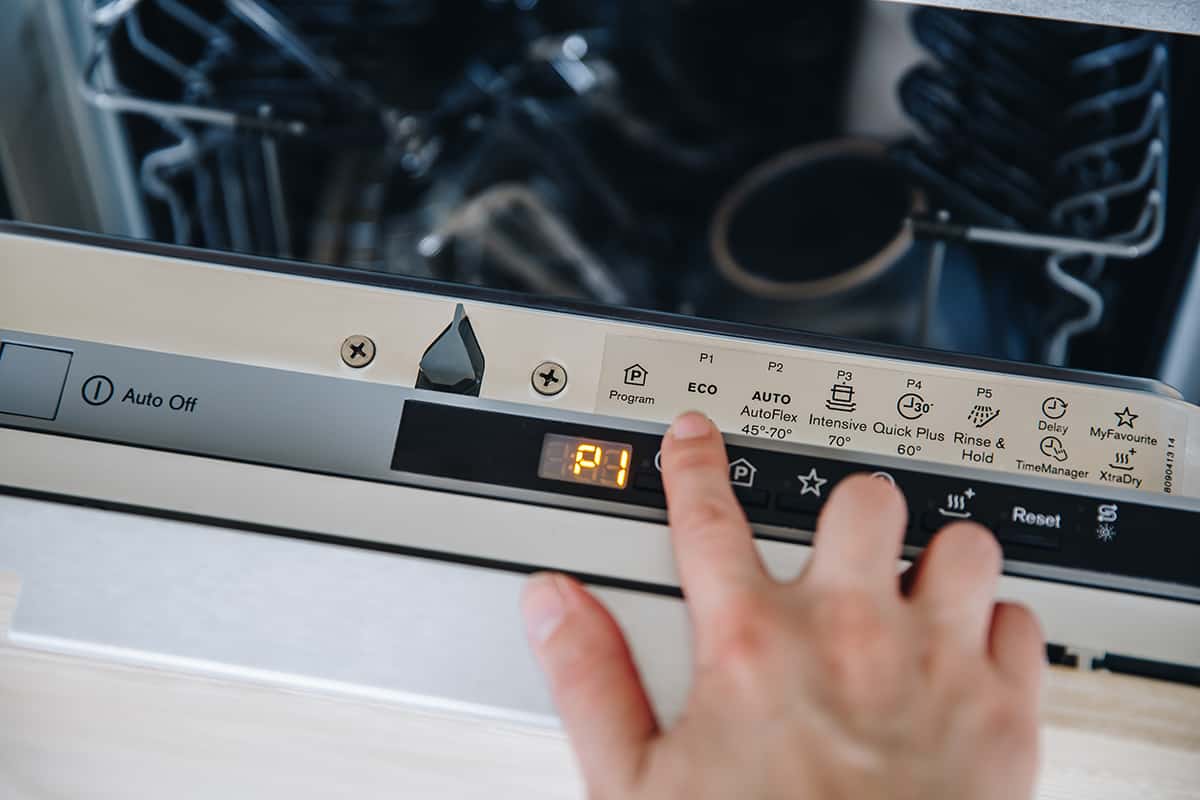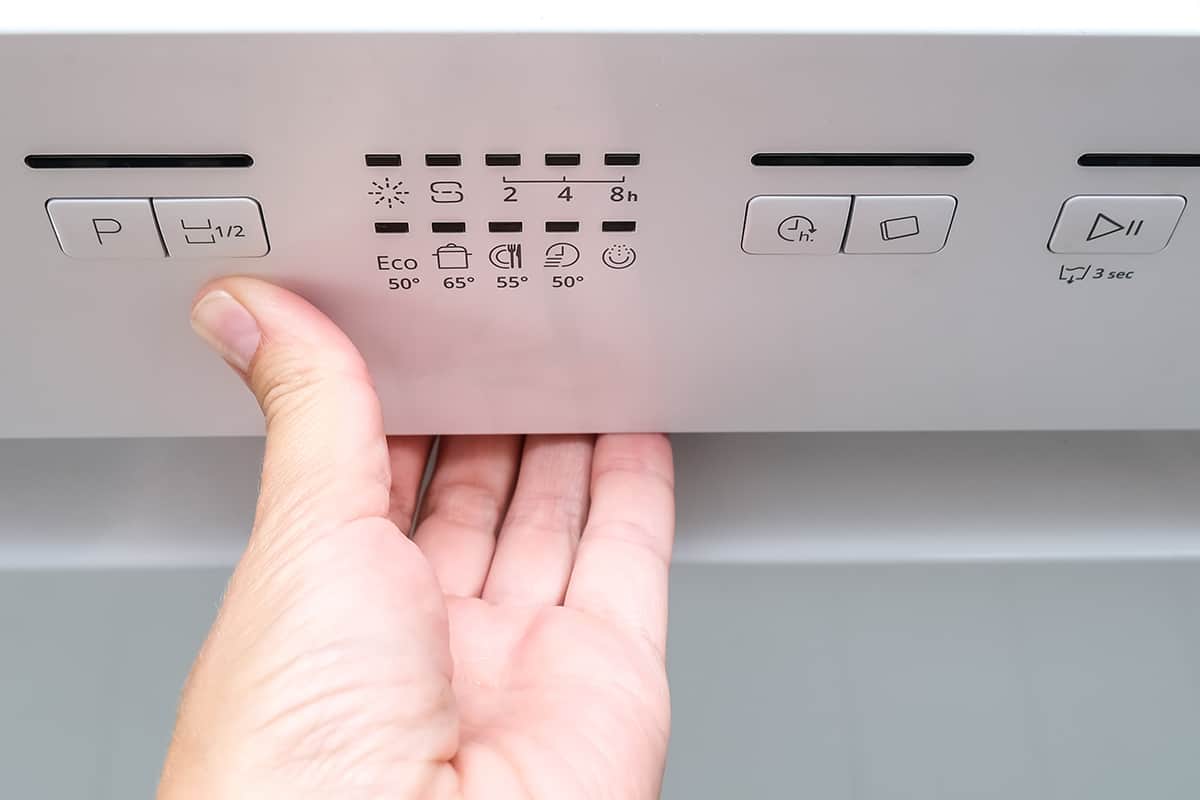As straightforward as a KitchenAid dishwasher is, there will be a point in time where it will experience some sort of functional problem. And when that time comes, you’ll be glad to have the knowledge of resetting the dishwasher in your back pocket. So, how exactly do you return a KitchenAid dishwasher to its factory settings?
To reset most KitchenAid dishwasher models, you have to hit the Hi-Temp Scrub and the Energy Saver Dry buttons one after the other in rapid succession 5 times, which will trigger the display’s lights to turn on for 5 seconds. The reset process should take another 10 minutes to complete.
After doing so, you should start a new dishwashing cycle to see whether it has reset properly. Alternatively, you can perform a manual reset by unplugging the appliance, waiting five minutes, and plugging it back in.
There are plenty of reasons why you should restore the dishwasher to its factory settings, which I will describe down below.
Reasons for Resetting a KitchenAid Dishwasher

You might be wondering why you would even have to reset your KitchenAid dishwasher. Well, the fact of the matter is that dishwashers, like any electronic, will have problems during its lifetime. And one of the ways to get rid of such problems, such as inexplicable starts and stops, is by resetting the dishwasher.
Another reason why you should reset your KitchenAid dishwasher is that some of its basic functions, like sensing a closed door or inputting cycle options, can be misread or unread entirely. By returning the dishwasher to its original state, you are getting rid of irregularities in the system.
Now, resetting a dishwasher, while helpful, is not a solution for every technical problem. Some issues you may face have more to do with the hardware than the software, and as such, you should reach out to a trusted technician to diagnose and fix the problem.
That said, when it comes to the majority of technical malfunctions, a quick reset might do the trick.
Let’s take a look at how you can reset your KitchenAid dishwasher.
How to Reset a KitchenAid Dishwasher
Resetting a KitchenAid dishwasher is a process that involves wiping its memory and restoring it to its factory settings. To do this, you should take a look at the included paperwork in the dishwasher’s box. If you lost it, you can find a digital manual on the official KitchenAid website.
If you have the time, I’ll show you the multiple ways of resetting the majority of KitchenAid dishwashers below.
Factory Reset
Turn off the dishwasher and close the dishwasher’s door. If the door is even slightly ajar, the dishwasher will not register what you are trying to do. So, if the following steps don’t work, there’s a good chance that the door is still open.
- Press the High-Temp Scrub and Energy Saver Dry buttons one after the other 5 times in rapid succession. The light to the corresponding button to turn on and off before all of the lights turn on.
- At this time, the lights on the control panel should remain on for around 5 seconds. If the lights don’t turn on at the same time, repeat the previous step.
- After 5 seconds, the lights will turn off. This indicates that the dishwasher has entered Diagnostics Mode and is performing an evaluation before it begins the reset process. You will hear the dishwasher’s inner components begin to make noises, which is completely normal.
- Wait for roughly 20 minutes or until all sounds of the dishwasher have stopped. When it doesn’t produce any noise, that means the dishwasher is fully reset.
- Optionally, you can run a rinse cycle by pressing the Rinse button. This will flush the inside of the dishwasher, making it almost as good as new.
Manual Reset
If, for whatever reason, you cannot restore your dishwasher to its factory settings, all is not lost just yet. You don’t necessarily have to perform a hard reset to restore the dishwasher; instead, you can perform a manual reset or a cold reboot.
This process is fairly straightforward and takes considerably less time. However, the results are not always as good as a factory reset.
- Turn off the dishwasher and close the door.
- Unplug the dishwasher’s power cable from the wall outlet. Alternatively, you can turn off the circuit breaker that leads to the dishwasher.
- Wait for 5 to 10 minutes before plugging the dishwasher back in or flipping on the circuit breaker switch.
- Turn the dishwasher on.
- Test it out by performing a quick wash cycle or running the rinse cycle.
Cycle Reset
Say you have input different washing cycles into your KitchenAid dishwasher but want to change them to another setting. Instead of waiting for the wash cycle to complete, you can cancel it completely by pressing the Cancel and Drain buttons simultaneously. Doing so will stop the dishwasher from continuing with the cycle any further, allowing you to input different wash cycle settings.
Make sure you do not do this too often as it may cause functional problems in the future. Such problems include door errors, stopping mid-cycle, or restarting a wash cycle inexplicably. If that happens, you will need to perform a factory reset or a manual reset.
Why Won’t My KitchenAid Dishwasher Reset?
The purpose of a factory reset or manual reset is to restore its hardware components to their original settings. However, there might be a time when your dishwasher is unable to restart, and all of its functional problems will persist.
If this is the case, you should check the power cable and see whether or not it is faulty. If the cable doesn’t appear damaged in any way, then there’s a possibility that the internal computer board may have blown a fuse. In incredibly rare instances, the dishwasher’s thermal fuse may have become damaged. This is typical in dishwashers that are older than 5 years.
Those without any technical expertise in fixing dishwashers should consider reaching out to a professional technician to diagnose and fix the problem.






